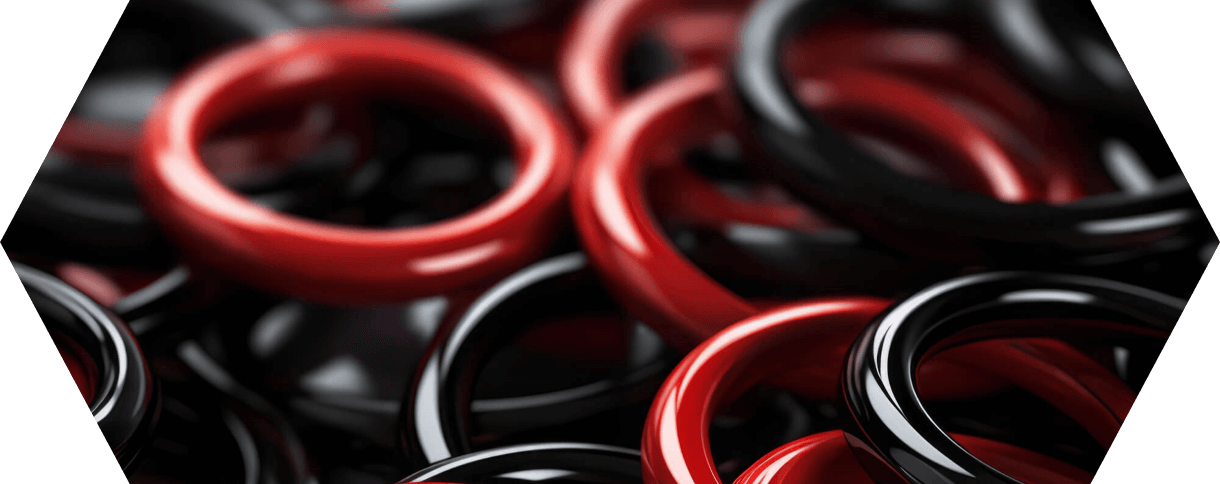
10 questions: O-ring data sheets
In this short article, we answer the 10 most important questions about the correct design of O-ring data sheets in a simple and understandable way.

Ideally, O-rings fulfill their task inconspicuously. But they can paralyze entire systems if they fail. This quickly results in high downtime costs or entire product batches have to be replaced due to
possible contamination.
However, with the appropriate experience in handling sealing elements, many of the causes of failure can be avoided.
During operation, O-rings not only come into contact with air, water and lubricants. While these supposedly harmless substances can cause considerable damage to elastomer materials, the industry uses numerous other aggressive process media. The case-specific selection of an O-ring material with appropriate media resistance is crucial for a durable seal.
The O-ring is exposed to numerous stresses in the sealing system. Failure is often caused by a complex interaction of many factors.
Possible interactions between media, temperatures and mechanical loads are often difficult to predict at the time of commissioning. This makes a thorough damage analysis all the more important in the event of a seal failure. Experts distinguish between these categories of damage.
Mechanical influences act when pressure is applied to the O-ring. This results in deformations that are not always completely reversible.
If the position of the components to be sealed changes in relation to each other, this can lead to leaks. Mechanical damage can also occur during installation due to twisting, crushing or overstretching.
In addition, common O-ring materials are subject to an ageing process. They can only bridge the sealing gap thanks to their elastic properties.
This is due to the wide-meshed cross-linking of polymers that occurs during vulcanization. In this core process of O-ring production, an extruded rubber blank is given elastic cohesion under the effect of heat and pressure.
From this point onwards, the O-ring returns almost completely to its original shape after an externally induced change in shape.
However, demolding also marks the start of the ageing process for the sealing ring. Even room air at normal temperatures can cause O-rings to gradually lose their desired properties. This is particularly pronounced with O-rings made of NBR: Ozone is a molecule made up of three oxygen atoms and is.
It is formed by UV radiation and occurs naturally in the atmosphere. Electrical appliances can also act as a source of ozone. Ozone is very reactive and has an effect on NBR. The gas breaks unsaturated carbon bonds in the elastomer and reduces its cohesion.
As a result, the material becomes brittle. If they are not protected from contact with the gas during storage, NBR O-rings can be significantly damaged before they are even used. Other elastomers also age to a greater or lesser extent depending on the formulation.
In industrial applications, O-rings come into contact with a wide range of media. In the food industry, these include oils and flavorings. Aggressive cleaning and sterilization media are also used. In the pharmaceutical and chemical industries, O-rings are exposed to the entire spectrum of acids, alkalis and solvents.
Damage to the O-ring by process media can follow two mechanisms. The physical influence usually results in swelling of the O-ring. The medium penetrates the elastomer material.
The consequence is an increase in volume, which can damage the polymer matrix. The sealing element loses some of its strength, but remains elastic. As a result, it is more susceptible to chipping or gap extrusion. Groove overfilling can also occur.
The volume of the O-ring then significantly exceeds the installation space defined by the width and depth of the groove. In dynamic applications in particular, even relatively low swelling can lead to failure.
After all, friction is particularly crucial in such systems. Expected swelling should already be taken into account when designing the installation situation. The reverse effect to swelling is also possible. During shrinkage, the contact medium releases compound components from the O-ring.
This loses volume so that a minimum compression between the sealing surface and the groove base is no longer guaranteed. The consequence here is also the loss of the sealing effect. However, both processes can be at least partially reversible.
Now to the chemical destruction of the network structure of the elastomer materials, which makes the material hard and brittle. The medium directly attacks the network of long-chain polymers that gives the O-ring materials their elastic properties. The old long-chain bonds are replaced by shorter segments or the material is further cross-linked, resulting in greater rigidity.
In the case of a piston seal, this can lead to the radial contact pressure being completely lost due to the pre-tensioning of the O-ring. Even small pressure differences or mechanical stresses are sufficient to cause a leak. Experts look for these signs of a media attack when analyzing the damage:
– Loss of rubber elasticity and hardening
– Cracks and brittleness on the side exposed to the medium
– Significant swelling or shrinkage
– Stickiness of the surface
Basically, the following applies: The basis for the media resistance of an O-ring is created by the base polymer. It specifies further basic technical properties such as aging behavior and temperature limits. However, many additional components are used in the formulations of modern O-ring materials.
These include fillers, plasticizers, anti-ageing agents and vulcanization accelerators. The recipe components are used to precisely match the technical properties of the vulcanizate to the requirements.
The wide variety of rubbers allows a specific selection of suitable O-rings for the respective application.
The basic elastomers commonly used for O-rings differ in the structure of their polymer chains. However, there are also different cross-linking systems within an elastomer.
The cross-linking creates the elastic cohesion between the polymer chains. For example, FKM O-rings can be bisphenolic or peroxide cross-linked. The peroxide cross-linking increases the resistance to hot water. The material becomes more resistant to hydrolysis. This is the chemical process of polymer degradation through reaction with water. However, this is at the expense of the maximum operating temperature.
Engineers usually have to weigh up several factors when selecting materials. This is no different with silicone (VMQ).
The material is very suitable for food applications because it is physiologically inert. However, it has its weaknesses when it comes to steam sterilization in particular.
EPDM, on the other hand, is a material that is suitable for such hot water applications. Although O-rings made from this elastomer are particularly flexible to use and economical, there are also limits here. This is because certain fats or oils cause the material to swell.
For this reason, contact between EPDM and these substances must be avoided at all costs during installation and storage. The reason for this is a similar charge distribution in the molecules. It ensures that the media can dissolve EPDM.
In contrast, O-rings made of NBR are highly resistant to oils and natural gases. This is mainly due to the content of acrylonitrile (ACN). However, elasticity and resilience decrease as the proportion of compound increases. NBR O-rings are not suitable for use with hot process water or solvents. In addition, resistance to ageing and weathering is limited.
FKM and FFKM are fluorinated elastomers. This means that at least a large proportion of the hydrogen atoms in the polymer are replaced by fluorine.
This composition also ensures good resistance to mineral oil-based media. In addition, they hardly swell in the liquids.
They are therefore very suitable for long-term use. The fluorinated elastomers are also characterized by their resistance to ageing. As a fully fluorinated rubber, FFKM is a further development of FKM.
O-rings made from this material are suitable for significantly higher maximum temperatures than FKM. FFKM is the elastic O-ring material with the best resistance properties to solvents, aggressive acids and alkalis. However, the costs for the sealing elements are comparatively high.
PTFE has a very similar resistance profile to FFKM. However, the material lacks elasticity, a key property for sealing elements. PTFE O-rings are therefore rather unsuitable for mechanical loads. However, further development can partially overcome this obstacle.
PTFE-coated elastomers combine media resistance with the ability to change shape flexibly. With FEP and PFA, however, there are fluorinated polymers that are even better suited to the production of hybrid sealing elements with an elastomer core.
“I am convinced that we should share our knowledge with the world. I hope I have been able to answer all your questions. If you have any further questions, please feel free to contact us at any time. We will be happy to help you.”

Lord of the O-rings
Author of the sealing academy

In this short article, we answer the 10 most important questions about the correct design of O-ring data sheets in a simple and understandable way.

In this short article, we answer the 10 most important questions about the correct design of O-ring grooves in a simple and understandable way.

In this short article, we answer the 10 most important questions about the correct storage of O-rings in a simple and understandable way.
You need to load content from reCAPTCHA to submit the form. Please note that doing so will share data with third-party providers.
More Information